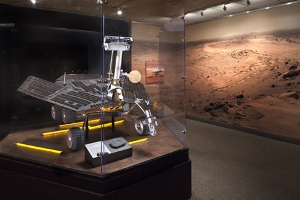Jan 15 2014
It’s an exploration celebration: The Smithsonian Institution’s National Air and Space Museum in Washington, D.C., has opened a new exhibit, “Spirit & Opportunity: 10 Years Roving Across Mars.”
 A full-scale replica of the twin rovers Spirit and Opportunity can be examined in a new exhibit at the Smithsonian's National Air and Space Museum. Source: Eric Long, Smithsonian Institution
A full-scale replica of the twin rovers Spirit and Opportunity can be examined in a new exhibit at the Smithsonian's National Air and Space Museum. Source: Eric Long, Smithsonian Institution
The retrospective recounts the Mars Rovers’ tandem missions in colorful, data-packed images, as well as the Cornell scientific triumphs of the rovers Spirit and Opportunity – when they scooted, scouted and scoured Earth’s neighboring, iron-oxidized planet.
“Mission success came about as a result of the efforts of thousands of committed people. But I think for all of us there’s a great satisfaction in seeing this exhibit,” said Steve Squyres, Cornell professor of astronomy and principal scientist on the mission. “Part of that satisfaction, of course, comes from the story of exploration and discovery that the exhibit tells. But the other part comes from seeing not the pictures on the walls, but the museum visitors who are there to look at the pictures.”
Spirit and Opportunity, the twin Mars Exploration Rovers, were launched from Cape Canaveral, Fla., in the summer of 2003 and each landed on the red planet in January 2004. Squyres led other Cornell professors, researchers and students on this scientific mission across the solar system. Cornell designed, built and outfitted the rovers’ scientific instruments and mission accoutrements.
“Our rovers were built by people like me who were inspired by space missions, both human and robotic, back in the 1960s and 1970s,” said Squyres. “If Spirit and Opportunity can provide the same kind of inspiration to others, then that’s as important a part of our legacy as our discoveries are.”
Squyres and the other mission scientists sought Martian rocks and soil that held clues to the presence of water in planet’s past. Cornell’s contributions amounted to a multitasking robotic geologist: Panoramic Camera (Pancam), Miniature Thermal Emission Spectrometer (Mini-TES), Mössbauer spectrometer, the Rock Abrasion Tool (RAT), Alpha particle X-ray spectrometer (APXS). And Bill Nye ’77 helped design the color-calibration sundial.
Surrounded by super air bags, each rover had landed like a beach ball skipping across a windswept, sandy seashore – after a nerve-wracking (for their Earth-bound human followers) descent through the Martian atmosphere. Spirit landed Jan. 3, 2004, at Gusev Crater, while Opportunity landed at Meridiani Planum at Eagle Crater Jan. 25, 2004.
One of the earliest discoveries was made near Eagle crater. Fine basaltic sand and hematite-rich spherules excited the scientists. The hematite-rich spherules – which the scientists dubbed “blueberries” – were embedded in the bedrock. The scientists interpreted these spherules as concretions formed by the geological process called diagenesis – which implied the presence of liquid water at some point in Martian natural history.
Spirit and Opportunity each far exceeded the initial 90-Martian-day life expectancy. Spirit eventually traveled 4.8 miles over more than six years before thick dust blocked the solar array’s ability to gather energy and survive the harsh Martian winter. Opportunity still roves the planet; it has traveled more than 23.6 miles over 10 years.